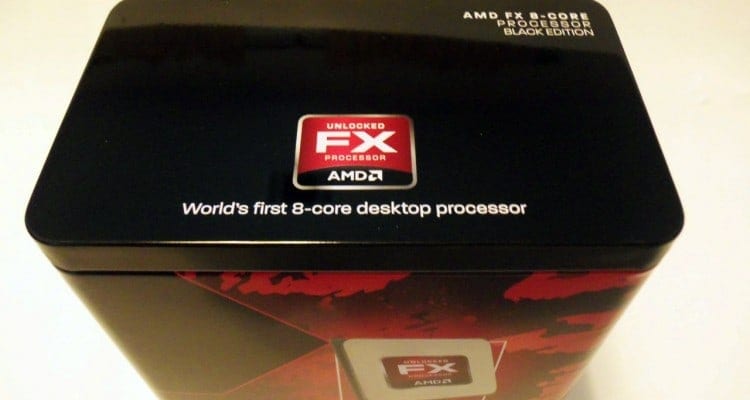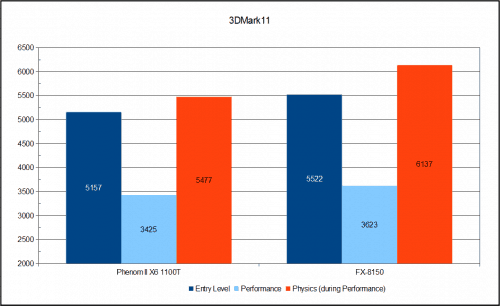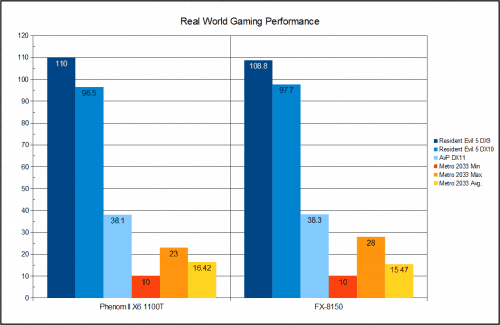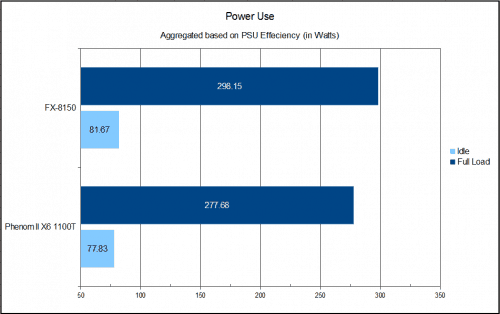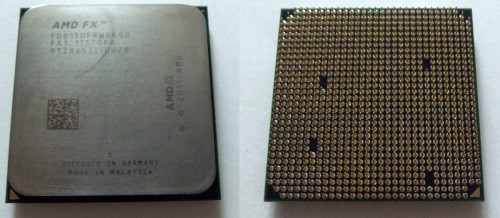3DMark11 – Synthetic Graphical Performance
Now lets look into the one thing we are all concerned about: Gaming performance. I will start with 3DMark11 to get an idea of what should be expected from FX-8150 now and in the future.
Much like PCMark07, the FX-8150 holds a nice lead in both Entry and Performance testing. It also has a big impact on the Physics score. Note that the Physics score is shared with the GPU in 3DMark11 with the GPU handling soft body object, with the CPU working the rigid body physics.
Real World Graphical Performance (Resident Evil 5, AvP benchmark, Metro 2033)
Now lets take a look at real game performance from the FX-8150. AvP was tested at DX11 with its default settings. Resident Evil 5 was tested with vsync off, frame rate unlocked, 8xAA, and high everything else. Metro 2033 on its “Very High” preset which included 4xMSAA and 16xAF. These were all tested at 1920 x 1080.
In these tests the FX-8150 and 1100T go back and forth. DX9 shows the FX-8150 falling behind, but it has a very small advantage in DX10 and DX11. This is not unexpected seeing as other older apps have not performed as well as hoped.
In Metro 2033 both have the same minimum frame rate. The FX-8150 manages to have a higher maximum frame rate, but falls 1 FPS behind in average. While playing the exact same section for benchmarking with FRAPS running, my personal character movement could account for this difference. As such, I say to only consider the minimum frame rate which amounts to no gain for either CPU.
Power Consumption
This is a simple test of the power from from the wall using a Kill-a-watt meter. I then adjusted the scores based on the tested efficiency of my Antec HCP 850W PSU to get a better idea of what the PC system is using.
As expected of the FX-8150 with more components, there is an increase in power consumption. The FX-8150 alone is doing pretty well with idle power considering its high clock speed. I noticed there were three major voltage points for the FX-8150. 0.84V for idle, 1.2375V for standard, and 1.4125V for turbo. This is for my chip in particular as these numbers will vary slightly for each chip.
Final Thoughts (For Now)
I am honestly not sure what to make of the FX-8150. I did not really lose or gain any performance in games. While this is disheartening, such is not the case with Sandra 2011. In every benchmark I ran in Sandra, with the exception of the SHA-256 results, shows FX-8150 far far ahead of the 1100T. The FX-8150 seems to shine brightly in computational workloads.
When you turn on an application or perform a certain task, I am not sure if I will get i7 Sandy Bridge or Phenom II 965 performance. Newer applications and benchmarks that take full advantage of the new instructions sets, perform between the INTEL i7 2500K and 2600K. Older software and single thread applications perform below the 1100T and closer to my AMD Phenom II X4 955. While it is not bad performance it is inconsistent and does not encourage a sense of an upgrade in these cases.
My gaming performance is being limited by my GPU making most of the results superfluous, but trends do arise. I notice the older the titles core engine, the worse the FX-8150 performs. I will examine this further with a more recent title in Part Two of our evaluation.
The other drastic change is AMD has improved memory bandwidth. This should prove to translate to great performance in multiple GPU setups and memory intensive programs. While this does not help with the HD 6850, we will look at a few of the issues I ran into here. In Part Two of the FX-8150 review, we will look at Overclocking for both the FX-8150 and 1100T, controlling the affinity for single threaded apps to prevent the “first available core” scenario. Well also be testing with newer titles like Deus Ex: Human Revolution and give a comparison to INTEL’s Core i7 2600k, plus other specialized tests to help you make an informed purchasing decision.
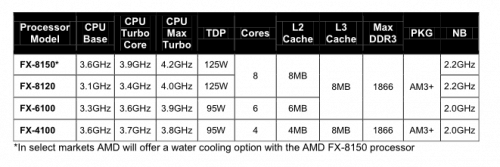 Once again, the MSRP of the FX-8150 with no water cooling is $245. You can also find the FX-8120 for $205, FX-6100 for $165, and FX-4100 for $115. You should expect $20 to $40 markups at your favorite retailer. If you take into account the general performance and gaming performance of the FX-8150, these seem to be well placed in price. The question is who should be considering moving to the Scorpius Platform? We will examine the FX-8150 more in Part 2 very soon and my final verdict.
Once again, the MSRP of the FX-8150 with no water cooling is $245. You can also find the FX-8120 for $205, FX-6100 for $165, and FX-4100 for $115. You should expect $20 to $40 markups at your favorite retailer. If you take into account the general performance and gaming performance of the FX-8150, these seem to be well placed in price. The question is who should be considering moving to the Scorpius Platform? We will examine the FX-8150 more in Part 2 very soon and my final verdict.
For now, I can see the Bulldozer design and the Zambezi chips being something great with a few updates to Windows 7 and software that understands how the chip is designed. I just hope I can see some of these improvements soon through software updates, BIOS updates, and/or AMD drivers. The problem here is a lot of the optimization that would help Zambezi is out of AMDs hands.
Help Us Improve Our Reviews By Leaving a Comment Below!

